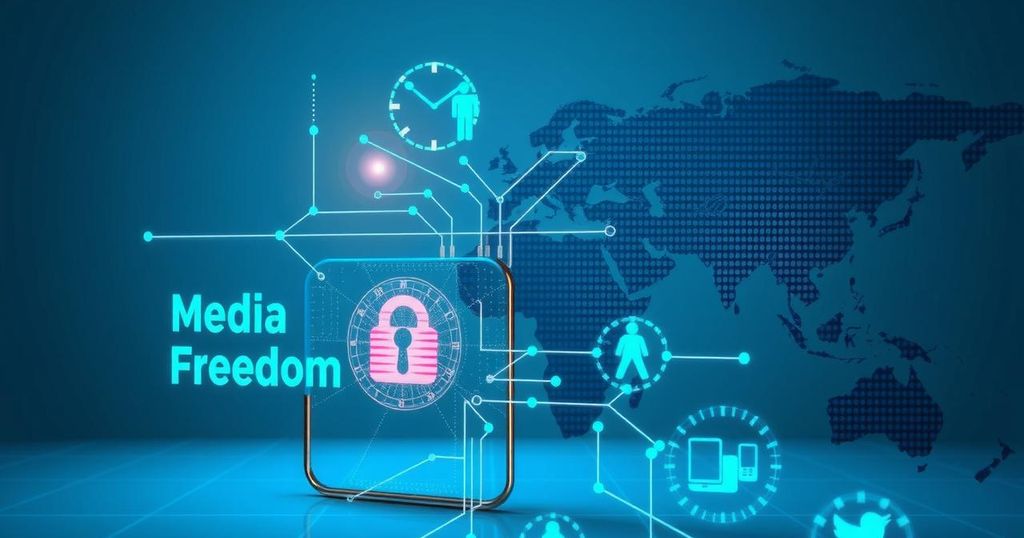The Grim Intersection of AI and Press Freedom
Press freedom is increasingly endangered globally, with rising violence against journalists and the misuse of AI technologies exacerbating the situation. The UN underscores both the promise and peril of AI in journalism. Special attention is drawn to the unique dangers faced by women reporters. World Press Freedom Day calls for urgent action to safeguard press independence and address the risks posed by evolving technology.
Press freedom is hanging by a thread worldwide, with reports of journalists facing violence, censorship, and the shuttering of their workplaces on the rise. A sobering statistic from the United Nations indicates that at least 20 media professionals have lost their lives since January 2025. Disturbingly, over 80% of these killings remain unpunished. It’s clear that the landscape is growing darker, and the increasing use of technology, particularly artificial intelligence (AI), is only worsening the situation.
AI is reshaping journalism and media, revolutionizing the ways information is gathered, processed, and shared. The United Nations highlights both the opportunities and significant hurdles that accompany this rapid development. On one hand, AI can enhance freedom of expression—making information more accessible and facilitating global communication. But, conversely, it carries alarming risks.
The UN raised a red flag, stating that AI can easily disseminate false information, fuel online hate speech, and enable newer forms of censorship. Further, certain parties are employing AI for mass surveillance of journalists and citizens alike, creating a chill that stifles open communication. The control that major tech platforms have over content visibility means they have become gatekeepers of the information we receive. There’s a real fear that AI might homogenize global media, sidelining diverse viewpoints and squeezing out smaller outlets.
Volker Türk, the United Nations High Commissioner for Human Rights, pointed out that AI algorithms shape our viewing experiences, molding our beliefs and perceptions about reality. Wichtigly, he noted how politicians are weaponizing disinformation through AI, pushing personal agendas while states are surveilling journalists, infringing on privacy. The knock-on effect? A chilling atmosphere for all media workers, with women journalists bearing the brunt of the assault.
Women in journalism, especially, grapple with dangers associated with technology-facilitated gender-based violence. UNESCO warns that AI exacerbates risks for women in the digital age. It can spawn deepfakes and misinformation campaigns, undermining the credibility and safety of female journalists. Such AI-driven harassment not only puts them at risk but also threatens to limit vital information dissemination.
In a wider context, Mr. Türk emphasized concerns regarding AI’s concentration of power, where a handful of companies seem to wield almost unfettered control over AI technology, extending their influence across the global media landscape. Clearly, it’s imperative to harness the potential benefits of AI for journalists while simultaneously addressing the multi-faceted challenges it introduces.
On May 3rd, the world marked World Press Freedom Day, a United Nations initiative aimed at advocating for press freedom. It’s an annual reminder to assess the health of press freedom, standing against attacks on media independence, and honoring those journalists who’ve paid the ultimate price in pursuit of truth. This year, the focus centered on AI’s profound impact on journalism.
Mr. Türk called this day a pivotal moment, urging states to make pledges to safeguard journalists from violence, hate propaganda, and intrusive surveillance. He emphasized the necessity for transparency regarding data use, content curation, and algorithm design. In an optimistic turn, he announced a collaboration between his office and UNESCO to guide tech companies on the risks their tools pose to journalists.
With these threats looming large over journalists and the media landscape, it’s going to take a concerted effort to protect the integrity and independence of the press—a cornerstone for thriving democracies.
In summary, the world faces growing threats to press freedom, intensified by AI technologies that can spread misinformation, surveil journalists, and manipulate public opinion. With women journalists particularly vulnerable to tech-facilitated violence, the situation calls for urgent action. World Press Freedom Day serves as a critical reminder of the need for protective measures and transparency in how information is controlled. Moving forward, it’s essential to navigate the challenges posed by AI while maximizing its potential to support journalism, all in the name of protecting democratic values.
Original Source: www.forbes.com




Post Comment